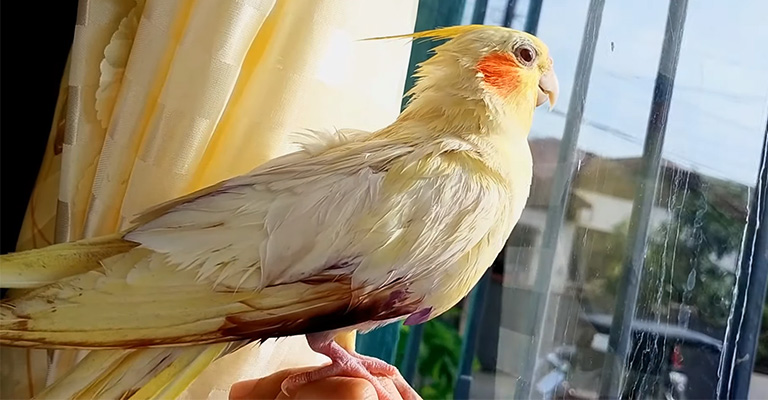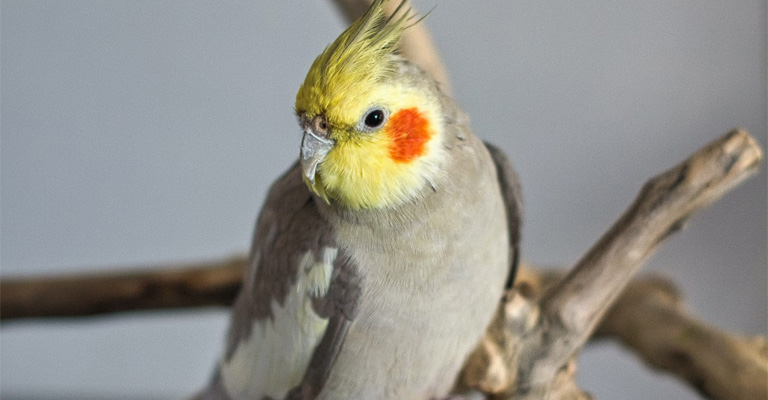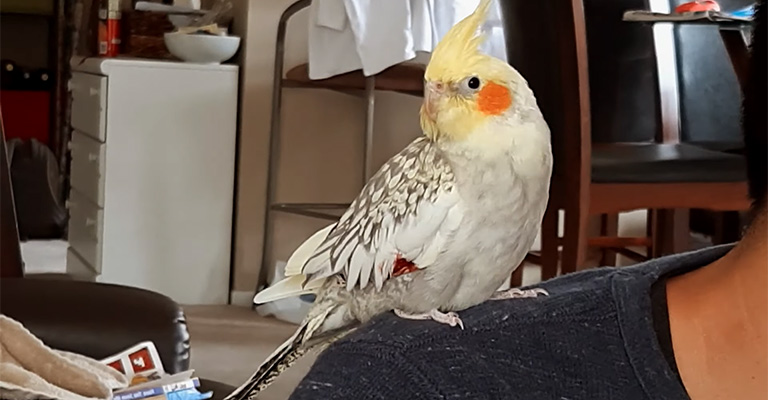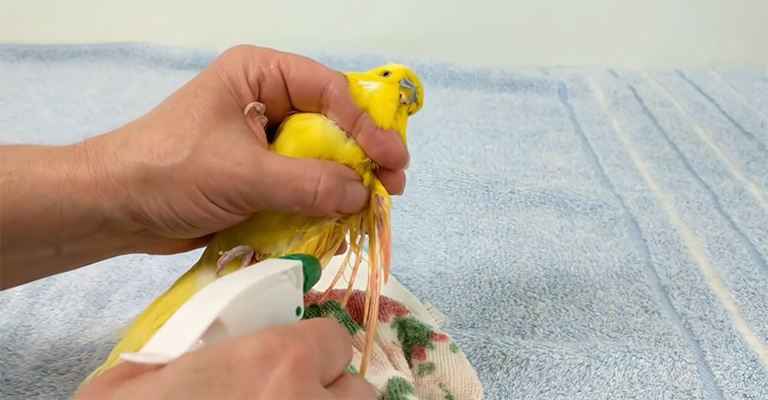Cockatiels are popular pet birds known for their vibrant plumage and playful nature. However, like any other living creature, they can experience health issues. One common problem that cockatiels may encounter is a broken blood feather.
Blood feathers are new feathers that are still growing and have a blood supply running through them. When a blood feather breaks, it can lead to bleeding and discomfort for the bird.
Understanding the causes, diagnosing the condition, and providing appropriate treatment is crucial for the well-being of the cockatiel. In this article, we will explore broken blood feather cockatiel – causes, diagnosis, and treatment.
By gaining knowledge about this condition, cockatiel owners can ensure prompt and effective care for their feathered companions, promoting their overall health and happiness.

Broken Blood Feather Cockatiel: Causes, Diagnosis, and Treatment
A broken blood feather in a cockatiel can be a concerning situation for bird owners. Blood feathers are new feathers that are still growing and have a blood supply running through them. Below are all the details you need to know about a broken blood feather in cockatiels:
Causes of a Broken Blood Feather in a Cockatiel
When a blood feather breaks, it can result in bleeding and discomfort for the bird. Several factors can cause a broken blood feather in a cockatiel.
Trauma or Injury
One of the most common causes of a broken blood feather in a cockatiel is trauma or injury. Cockatiels are active birds that love to explore their surroundings.
They may accidentally collide with objects, fly into windows, or get their feathers caught in cage bars. These incidents can lead to a broken blood feather.
Rough Handling
Rough handling by humans can also cause a broken blood feather in a cockatiel. If a bird is mishandled or grabbed too tightly, it can result in feather damage. It is important to handle cockatiels gently and avoid pulling or tugging on their feathers.
Wing Clipping
Wing clipping is a common practice among bird owners to prevent their pets from flying away. However, improper wing clipping can lead to broken blood feathers. If the feathers are cut too short or unevenly, they can become weak and prone to breaking.
Feather Chewing or Overpreening
Cockatiels are known for their preening behavior, which involves grooming their feathers using their beaks. However, excessive feather chewing or overpreening can cause damage to the feathers, including blood feathers. This can occur due to stress, boredom, or certain medical conditions.
Nutritional Deficiencies

A poor diet lacking essential nutrients can weaken a cockatiel’s feathers, making them more susceptible to breakage. Nutritional deficiencies, particularly in vitamins A, D, and E, can affect feather health and lead to broken blood feathers.
Disease or Infection
Certain diseases or infections can weaken a cockatiel’s feathers, making them more prone to breaking. Conditions such as feather mites, fungal infections, or bacterial infections can affect the integrity of the feathers, including blood feathers.
Cage Accidents
Cockatiels spend a significant amount of time in their cages, and accidents can happen even within the confines of their enclosure.
Cockatiels may get their feathers caught in cage accessories, such as toys or perches, leading to a broken blood feather. It is important to ensure that the cage is free from any sharp edges or potential hazards that could cause feather damage.
Aggressive Interactions with Other Birds
If a cockatiel shares its living space with other birds, aggressive interactions can occur. Pecking, biting, or aggressive behavior from other birds can result in broken blood feathers.
It is crucial to monitor the interactions between birds and provide separate spaces if necessary to prevent injuries.
Environmental Factors
Environmental factors can also contribute to broken blood feathers in cockatiels. Dry air, low humidity levels, or drafts can cause the feathers to become brittle and more prone to breakage.
It is important to maintain a suitable environment for cockatiels, with proper humidity levels and protection from drafts, to promote healthy feather growth and minimize the risk of broken blood feathers.
Diagnosis of a Broken Blood Feather Cockatiel

Diagnosing a broken blood feather in a cockatiel typically involves a visual examination by a veterinarian who specializes in avian care. Here is an overview of the diagnostic process:
Physical Examination
The veterinarian will perform a thorough physical examination of the cockatiel, paying close attention to its feathers and overall condition. They will look for any signs of bleeding, feather damage, or abnormalities.
Feather Assessment
The veterinarian will carefully examine the feathers, including the broken feather, to determine if it is a blood feather. Blood feathers have a visible blood supply running through the shaft. The veterinarian may use a magnifying tool or light source to get a better view of the feather.
Bleeding Assessment
If the feather is broken and bleeding, the veterinarian will assess the severity of the bleeding. They may apply gentle pressure to stop the bleeding or use specialized techniques to control it.
Underlying Causes
In addition to diagnosing the broken blood feather, the veterinarian will also try to identify any underlying causes that may have contributed to the breakage.
They may ask questions about the bird’s environment, diet, handling, and any recent incidents that could have caused trauma or injury.
Additional Tests
In some cases, the veterinarian may recommend additional tests to rule out any underlying medical conditions that could affect feather health. These tests may include blood work, feather plucking analysis, or skin scrapings to check for parasites or infections.
Once the diagnosis is confirmed, the veterinarian will discuss the appropriate treatment options. This may involve removing the broken feather, applying styptic powder to stop bleeding, providing pain relief, and addressing any underlying causes.
It is important to follow the veterinarian’s instructions and provide proper care to promote healing and prevent further complications.
Treatment of a Broken Blood Feather Cockatiel

The treatment of a broken blood feather in a cockatiel typically involves a combination of immediate first-aid measures and veterinary care. Here is an overview of the treatment process:
First Aid Measures
If you notice a broken blood feather in your cockatiel, it is important to act quickly to minimize bleeding and prevent further injury. Here are some first-aid measures you can take:
- Apply gentle pressure: Use a clean cloth or gauze to apply gentle pressure to the base of the broken feather. This can help stop the bleeding. Avoid pulling on the feather, as it may cause more damage.
- Styptic powder or cornstarch: If the bleeding persists, you can apply styptic powder or cornstarch to the base of the broken feather. These substances help promote clotting and stop bleeding.
Veterinary Care
It is crucial to seek veterinary care for your cockatiel as soon as possible after noticing a broken blood feather. A veterinarian who specializes in avian care will provide appropriate treatment based on the severity of the injury. Here are some common veterinary interventions:
- Feather removal: In some cases, the veterinarian may need to remove the broken feather completely. This is done to prevent further bleeding and reduce the risk of infection.
- Hemostasis: If the bleeding is severe or difficult to control, the veterinarian may use specialized techniques to achieve hemostasis (stopping the bleeding). This may involve cauterization or the use of medical-grade adhesives.
- Pain management: Cockatiels may experience discomfort or pain due to a broken blood feather. The veterinarian may prescribe pain medication or recommend appropriate pain management strategies.
- Addressing underlying causes: The veterinarian will also address any underlying causes that may have contributed to the broken blood feather. This may involve addressing nutritional deficiencies, modifying the bird’s environment, or providing behavioral enrichment.
Post-Treatment Care
After the initial treatment, it is important to follow the veterinarian’s instructions for post-treatment care. This may include:
- Administering prescribed medications: If the veterinarian prescribes any medications, follow the dosage and administration instructions carefully.
- Monitoring for complications: Keep a close eye on the cockatiel for any signs of infection, excessive bleeding, or worsening of symptoms. Contact the veterinarian immediately if you notice any concerning changes.
- Providing a safe and stress-free environment: Ensure that the bird’s cage is free from hazards, and provide a calm and stress-free environment to promote healing.
Remember, the information provided here is a general overview, and it is essential to consult a veterinarian for a proper diagnosis and tailored treatment plan for your cockatiel’s specific situation.
FAQs
It is generally not recommended to remove a broken blood feather yourself, as it can be a delicate procedure that requires proper knowledge and tools. Improper removal can lead to further injury or excessive bleeding.
The healing time for a broken blood feather can vary depending on the severity of the injury and the individual bird’s healing ability. In most cases, it can take a few weeks for the feather to heal completely.
If the bleeding from a broken blood feather persists or is excessive, it is important to seek immediate veterinary care. In the meantime, you can apply gentle pressure to the base of the feather and use styptic powder or cornstarch to help stop the bleeding.
Yes, broken blood feathers can grow back. Cockatiels continuously molt and regrow their feathers. Once the broken blood feather is removed or naturally falls out, a new feather will start to grow in its place.
To help prevent broken blood feathers in your cockatiel, you can provide a safe environment. Ensure that the bird’s cage is free from sharp edges, hazards, or objects that could cause feather damage.
Final Words
Broken blood feathers can be a distressing condition for cockatiels, but with proper understanding and care, it can be effectively managed. Identifying the causes, such as trauma or improper grooming, is essential in preventing future occurrences.
If a broken blood feather is suspected, seeking veterinary assistance for a proper diagnosis is crucial to ensure the bird’s well-being. Treatment options may include feather removal, cauterization, or the use of styptic powder to stop bleeding.
Additionally, providing a calm and stress-free environment during the healing process is important. By being proactive and knowledgeable about broken blood feathers, cockatiel owners can help their feathered friends recover quickly and prevent complications.
Remember, the health and happiness of our avian companions rely on our dedication and care.